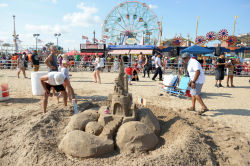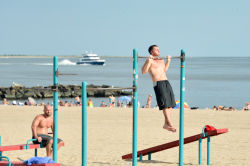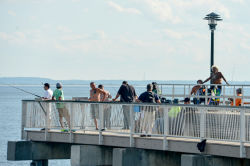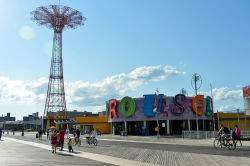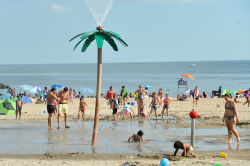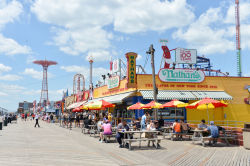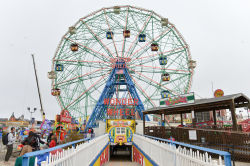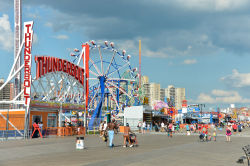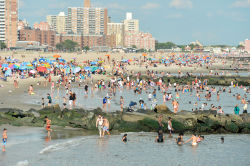Coney Island Beach & Boardwalk
Jackie Robinson and Pee Wee Reese Monument
Following the death in 1999 of Brooklyn Dodgers baseball team captain Pee Wee Reese, Stan Isaacs of Newsday and Jack Newfield of the New York Post wrote several columns encouraging a fitting public permanent tribute. Ultimately, the monument incorporated pioneering black athlete Jackie Robinson, whose friendship with Reese on and off the field, represented increasing racial tolerance in America.
Jackie Robinson (1919-1972) is legendary for his role as the first black professional baseball player in the major leagues. He was born in Cairo, Georgia, in 1919 and raised in Pasadena, California. He attended the University of California at Los Angeles, where he became the first student to earn varsity letters in four sports: baseball, basketball, football and track. He played football for the Los Angeles Bulldogs, before serving in the army during World War II.
After the war, Robinson played baseball in the Negro Leagues for the Kansas City Monarchs. His talent was soon recognized by Branch Rickey, general manager of the Brooklyn Dodgers, who signed Robinson on August 28, 1945 to join the Montreal Royals in the International League. The Royals were the Dodgers’ top “farm team”.
On April 15, 1947, Robinson made history as the first African-American to play in a major league baseball game. He paved the way for generations of black athletes to compete in America’s national pastime. Professional baseball, however, did not become fully integrated until 1959, when Boston Red Sox became the final team to sign a black player (Elijah Green).
Robinson went on to lead the Dodgers, as a second baseman, to six World Series appearances, retiring in 1956 with a lifetime batting average of .311. Following his induction into the National Baseball Hall of Fame in 1962, Robinson became a business entrepreneur. He was also active in the National Association for the Advancement of Colored People (NAACP), and served as a special assistant to Governor Nelson A. Rockefeller.
Harold Peter Henry “Pee Wee” Reese (1918-1999) was born in Ekron, Kentucky. He was the star short stop for Brooklyn, and later the Los Angeles Dodgers from 1940 to 1958. After his baseball career he served as a radio announcer and television sports analyst, and was inducted in the Baseball Hall of Fame in 1984.
Sculptor William Behrends is a North Carolina-based artist well known for his portraits of professional baseball players. Behrends conception pays tribute to a moment early in Robinson’s professional career as a Dodger, when at a game in Cincinnati he was the target of death threats and racist taunts. Reese, then team captain, publicly supported Robinson by walking over to him and putting his arm around him in a gesture of solidarity and conciliation. It is this touching vignette, with its broader implications for social progress that Behrends captures.
The sculpture stands at the center of a circular lawn and perimeter granite walkway designed by Ken Smith, and the base includes inscribed commentary related to the lives and achievements of the athletes. On November 1, 2005 dignitaries, supporters, friends and family—including Robinson and Reese’s widows--gathered in Coney Island at Key Span Park (now MCU Park, home of the Brooklyn Cyclones minor league baseball team) to dedicate this monument honoring sport, friendship and racial equality.
Related
Check out your park's Vital Signs
Clean & Safe
Green & Resilient
Empowered & Engaged Users
Share your feedback or learn more about how this park is part of a
Vital Park System
Downloads
Contacts
Park Manager: (718) 946-1353


